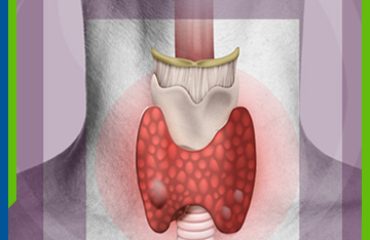
Thyroid cancer is a malignant lump developing inside thyroid nodules and is characterized by uncontrolled growth of cells. Only about 5% of thyroid nodules are cancerous. There are various types of thyroid cancer, and the treatment procedure depends on the type.
Papillary thyroid cancer
Papillary thyroid cancer is the most common type of thyroid cancer. The course of disease is more unproblematic than the other types. Almost none of the cases pose life threatening risks. Since it responds to radioactive iodine, few cases may require post-operative radioactive iodine treatment. Diagnosis can be made via fine needle biopsy in almost all of the cases. Additionally, ultrasound scan is used to assess metastasis in adjacent lymphatic glands, and surgical procedure is performed. Survival in post-operative 10 years is approximately 99%.
Medullary thyroid cancer
Medullary thyroid cancer is a type of neuro-endocrine tumor, and defined as uncontrolled growth of parafollicular C cells in thyroid glands. The disease may develop incidentally, and may also develop as part of certain syndromes due to genetic factors. Thus, family history has importance for patient assessment. Furthermore, parathyroid glands and adrenal glands should also be scanned. Metastasis to local lymphatic nodes as well as distant organs occur more often and faster in medullary thyroid cancer than other thyroid cancer types.
Follicular thyroid cancer
Follicular thyroid cancer is the third most common type after papillary and medullary thyroid cancer. It is found mostly among women between the ages of 40-60. It has no proven link with past radiation exposure. Follicular thyroid cancer generally spreads through blood system and has low risk of metastasis to lymphatic glands. Thus, bone, lung, brain and liver metastasis may occur.
Anaplastic thyroid cancer
Anaplastic thyroid cancer is an undifferentiated tumor originating from follicular epithelial cells that produce thyroid hormones. It is mostly found in women over the age of 65. Anaplastic thyroid cancers are very aggressive tumors, and more than half of the patients are already in stage 4 by the time of diagnosis. It is usually diagnosed after biopsy and histopathological analysis. Surgery, radiotherapy, chemotherapy, targeted therapy referred as tyrosine kinase and their combinations are administered in anaplastic thyroid cancer treatment. However, overall survival is very poor in this type.
Risk Factors in Thyroid Cancer
Presence of nodules in thyroid gland is the most significant risk factor. Exposure of the neck area to radiation in early ages is also considered as a risk factor.
Symptoms of Thyroid Cancer
Small sized thyroid cancers do not show any symptoms for many years, and they are identified as the tumor grows bigger, exerting pressure on surrounding tissues, causing symptoms such as pain, difficulty in swallowing, shortness of breath, swelling on the neck area.
Thyroid Cancer Treatment
The first step in thyroid cancer treatment is surgery. Chemotherapy and radiotherapy procedures are not employed in thyroid cancer treatment (except for types such as medullary cancer). Post-operative radioactive iodine treatment is administered to selected patients but this procedure is not suitable for all cancer patients. Necessity for this treatment should be evaluated by multidisciplinary endocrinology committee where endocrine surgeons, medical endocrinologists, nuclear medicine experts, pathologists and radiologists.




